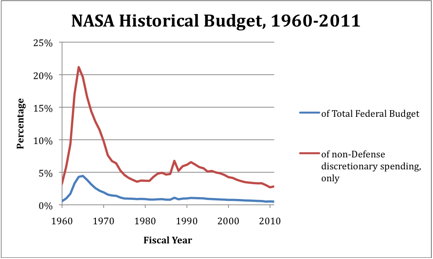
“If you don’t know where you are going, you will wind up somewhere else.”
–Yogi Bera
Last week, my colleagues across the agency and I received an email from NASA Administrator Charlie Bolden sharing highlights from the new NASA strategic plan nearing final release in early 2011. Here is an outline.
– NASA Strategic Plan 2011 Highlights –
Vision: NASA leads scientific and technological advances in aeronautics and space for a Nation on the frontier of discovery.
Mission: Drive advances in science, technology, and exploration to enhance knowledge, education, innovation, economic vitality, and stewardship of the Earth.
Goal 1: Extend and sustain human activities across the solar system.
1.1 Sustain the operation and full use of the International Space Station and expand efforts to utilize the ISS as a national lab for scientific, technological, diplomatic, and educational purposes and support future objectives in human space exploration.
1.2 Develop competitive opportunities for the commercial community to provide best value products and services to Low Earth Orbit and beyond.
1.3 Conduct robotic missions to scout destinations, find resources, and lower risk for future human exploration.
1.4 Develop an integrated architecture and capabilities for safe crewed and cargo missions beyond Low Earth Orbit.
Goal 2: Expand scientific understanding of the Earth and the universe in which we live.
2.1 Advance Earth System Science to meet the challenges of climate and environmental change.
2.2 Understand the Sun and its interactions with the Earth and the solar system.
2.3 Ascertain the content, origin and evolution of the solar system and the potential for life elsewhere.
2.4 Discover how the universe works, explore how it began and evolved, and search for Earth-like planets.
Goal 3: Create the innovative new space technologies for our exploration, science, and economic future.
3.1 Sponsor early stage innovation in space technologies in order to improve the future capabilities of NASA, other government agencies, and the aerospace industry.
3.2 Infuse game-changing and cross-cutting technologies throughout the nation’s space enterprise, to transform the nation’s space mission capabilities.
3.3 Develop and demonstrate the critical technologies that will make NASA’s exploration, science, and discovery missions more affordable and more capable.
3.4 Facilitate the transfer of NASA technology and engage in partnerships with other government Agencies, industry, and international entities to generate U.S. commercial activity and other public benefits.
Goal 4: Advance aeronautics research for societal benefit.
4.1 Develop innovative solutions and advanced technologies through a balanced research portfolio to improve current and future air transportation.
4.2 Conduct systems-level research on innovative and promising aeronautics concepts and technologies to demonstrate integrated capabilities and benefits in a relevant flight and/or ground environment.
Goal 5: Enable program and institutional capabilities to conduct NASA’s aeronautics and space activities.
5.1 Identify, cultivate, and sustain a diverse workforce and inclusive work environment that is needed to conduct NASA missions.
5.2 Ensure vital assets are ready, available, and appropriately sized to conduct NASA’s missions.
5.3 Ensure the availability to the Nation of NASA-owned strategically important test capabilities.
5.4 Implement and provide space communications and launch capabilities responsive to existing and future science and space exploration missions.
5.5 Establish partnerships, including innovative arrangements, with commercial, international, and other government entities to maximize mission success.
Goal 6: Share NASA with the public, educators, and students to provide opportunities to participate in our mission, foster innovation and contribute to a strong National economy.
6.1 Improve retention of students in STEM disciplines by providing opportunities and activities along the full length of the education pipeline.
6.2 Promote STEM literacy through strategic partnerships with formal and informal organizations.
6.3 Engage the public in NASA’s missions by providing new pathways for participation.
6.4 Inform, engage and inspire the public by sharing NASA’s missions, challenges, and results.
The previous NASA strategic plan was released in early 2006 and reflected NASA’s direction following the loss of Space Shuttle Columbia. A number of the items in the 2006 plan have come to pass, are nearing fruition or have been overcome by events.
– NASA Strategic Plan 2006 Highlights –
Vision: To advance U.S. scientific, security, and economic interests through a robust space exploration program. (See the Vision for Space Exploration.)
Mission: To pioneer the future in space exploration, scientific discovery, and aeronautics research.
Strategic Goal 1: Fly the Shuttle as safely as possible until its retirement, not later than 2010.
1.1. Assure the safety and integrity of the Space Shuttle work- force, systems and processes, while flying the manifest.
1.2. By September 30, 2010, retire the Space Shuttle.
Strategic Goal 2: Complete the International Space Station in a manner consistent with NASA’s International partner commitments and the needs of human exploration.
2.1. By 2010, complete assembly of the U.S. On-orbit Segment; launch International Partner elements and sparing items required to be launched by the Shuttle; and provide on-orbit resources for research to support U.S. human space exploration.
2.2. By 2009, provide the on-orbit capability to support an ISS crew of six crewmembers.
Strategic Goal 3: Develop a balanced overall program of science, exploration, and aeronautics consistent with the redirection of the human spaceflight program to focus on exploration.
Sub-goal 3A: Study Earth from space to advance scientific understanding and meet societal needs.
Sub-goal 3B: Understand the Sun and its effects on Earth and the solar system.
Sub-goal 3C: Advance scientific knowledge of the solar system, search for evidence of life, and prepare for human exploration.
Sub-goal 3D: Discover the origin, structure, evolution, and destiny of the universe, and search for Earth-like planets.
Sub-goal 3E: Advance knowledge in the fundamental disciplines of aeronautics, and develop technologies for safer aircraft and higher capacity airspace systems.
Sub-goal 3F: Understand the effects of the space environment on human performance, and test new technologies and countermeasures for long-duration human space exploration.
Strategic Goal 4: Bring a new Crew Exploration Vehicle into service as soon as possible after Shuttle retirement.
4.1. No later than 2014, and as early as 2010, transport three crewmembers to the International Space Station and return them safely to Earth, demonstrating an operational capability to support human exploration missions.
4.2. No later than 2014, and as early as 2010, develop and deploy a new space suit to support exploration, that will be used in the initial operating capability of the Crew Exploration Vehicle.
Strategic Goal 5: Encourage the pursuit of appropriate partnerships with the emerging commercial space sector.
5.1. Develop and demonstrate a means for NASA to purchase launch services from emerging launch providers.
5.2. By 2010, demonstrate one or more commercial space services for ISS cargo and/or crew transport.
5.3. By 2012, complete one or more prize competitions for independently designed, developed, launched, and operated missions related to space science or space exploration.
Strategic Goal 6: Establish a lunar return program having the maximum possible utility for later missions to Mars and other destinations.
6.1. By 2008, launch a Lunar Reconnaissance Orbiter (LRO) that will provide information about potential human exploration sites.
6.2. By 2012, develop and test technologies for in-situ resource utilization, power generation, and autonomous systems that reduce consumables launched from Earth and moderate mission risk.
6.3. By 2010, identify and conduct long-term research necessary to develop nuclear technologies essential to support human-robotic lunar missions and that are extensible to exploration of Mars.
6.4. Implement the space communications and navigation architecture responsive to Science and Exploration mission requirements.
What similarities to you see between the two strategic plans? Key differences?
Update February 14, 2011. The NASA Strategic Plan has been released. Get it here.













You must be logged in to post a comment.